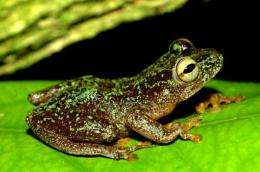'Extinct' frogs haven't croaked -- scientists

Delighted conservationists announced on Wednesday they had found two species of African frog and a Mexican salamander that had been feared to extinct.
The find was made by scientists combing some of the world's remotest sites on a quest to determine the fate of a hundred species of amphibians that have not been sighted for decades.
"These are fantastic finds and could have important implications for people as well as for amphibians," said Robin Moore, who is organising the search for a US-based wildife group, Conservation International, and the Amphibian Specialist Group (ASG) of the International Union for Conservation of Nature (IUCN).
"We don't know whether study of these animals could provide new medicinal compounds as other amphibians have -- and at least one of these animals lives in an area that is important to protect as it provides drinking water to urban areas," Moore said in a press release issued by Conservation International.
"But these rediscovered animals are the lucky ones. Many other species we have been looking for have probably gone for good."
The three discoveries include the cave splayfoot salamander (Chiropterotriton mosaueri), a pink-footed, brown-bodied cave-dweller that had not been seen since 1941.
Several of the little creatures were found underground in Mexico's Hidalgo province by scientist Sean Rovito from the Universidad Nacional Autonoma de Mexico, who had to abseil down a large pothole to reach their cave redoubt.
Another comeback is that of the Mount Nimba reed frog (Hyperolius nimbae), last seen in 1967, a small, well-camouflaged brown frog rediscovered in Ivory Coast by N'Goran Kouame from the University of Abobo-Adjame.
The third species is the Omaniundu reed frog (Hyperolius sankuruensis), "a beautiful frog with bright green, almost fluorescent-looking, spots on a dark brown background".
It was found in the Democratic Republic of Congo by Jos Kielgast from Denmark's Natural History Museum.
"It's pretty extraordinary to think about just how long it has been since these animals were last seen," said Moore.
"The last time that the Mexican salamander was seen, Glen Miller was one of the world's biggest stars, while the Mount Nimba reed frog hasn't been seen since the year the Beatles released 'Sgt Pepper's Lonely Heart Club Band' and the Omaniundu reed frog disappeared the year that Sony sold its first ever Walkman."
The discoveries are a rare glimmer of good news in biodiversity, the issue for top-level debate in New York this week at the UN development summit.
Under Target 7b of the Millennium Development Goals, UN members pledged to achieve by 2010 "a significant reduction" in the rate of wildlife loss.
Yet every expert assessment points to accelerating declines in many species, their numbers ravaged by habitat loss, hunting or the suspected impact of climate change.
In July 2009 the IUCN warned that Earth was hurtling towards a mass extinction.
Out of 44,838 species on the IUCN's famous "Red List", at least 16,928 were threatened with being wiped out, with amphibians among the worst hit, it said.
(c) 2010 AFP
















